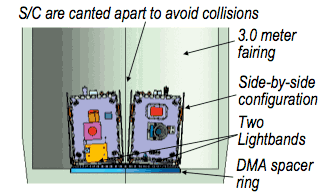The GRAIL spacecraft will be launched side-by-side on a
single Delta II vehicle during a 26-day launch period that opens on September
8, 2011. The mission was designed to avoid the December 10th, 2011 and June
4th 2012 lunar eclipses which interfere with the mission. The Goldstone complex
will implement initial acquisition including solar array deployment.

The trans-lunar cruise phase consists of a 3.5-month low-energy transfer via
the Sun-Earth Lagrange point 1 (EL1). Compared to a direct trajectory, this
low-energy transfer was chosen to reduce the spacecraft fuel requirements
(by ~130 m/s), to allow more time for spacecraft check-out and out-gassing,
and to increase the number of days available in the launch period each month.
Both spacecraft approach the Moon under the South Pole where they execute a
60-minute Lunar Orbit Insertion (LOI) maneuver to put them in an elliptical
orbit with a period of just over 8 hours. The LOI for each of the spacecraft
are separated by one day. Each LOI is simultaneously visible from the Goldstone
and Canberra DSN complexes.
A series of four maneuvers are then performed to reduce the orbits to near
circular with a mean 50-km altitude and 113-minute period. Further maneuvers
position the spacecraft to the desired initial separation distance, which
then drifts between 175 km to 225 km.
The 90-day Science Phase is divided into three 27.3-day nadir-pointed mapping
cycles. Two daily 8-hour DSN tracking passes acquire the science and "E/PO
MoonKam" data.
Following the Science Phase (or extended mission phase), a 5-day decommissioning
period is planned, after which the spacecraft will impact the lunar surface
in ~40 days.